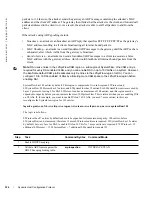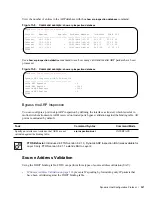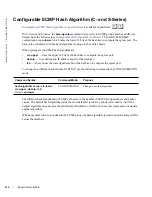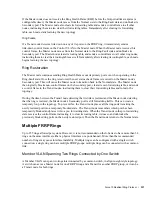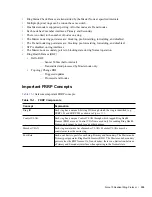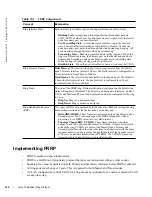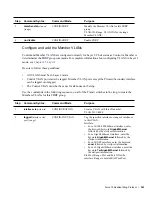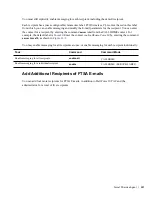
340
|
Force10 Resilient Ring Protocol
www.dell.com | support.dell.com
Implementing FRRP
•
FRRP is media and speed independent.
•
FRRP is a Dell Force10 proprietary protocol that does not interoperate with any other vendor.
•
Spanning Tree must be disabled on both Primary and Secondary interfaces before FRRP is enabled.
•
All ring ports must be Layer 2 ports. This is required for both Master and Transit nodes.
•
A VLAN configured as control VLAN for a ring cannot be configured as a control or member VLAN
for any other ring.
Ring Interface State
Each interface (
port
) that is part of the ring maintains one of four states
•
Blocking State
: Accepts ring protocol packets but blocks data packets.
LLDP, FEFD, or other Layer 2 control packets are accepted. Only the master
node Secondary port can enter this state.
•
Pre-Forwarding State
: A transition state before moving to the Forward
state. Control traffic is forwarded but data traffic is blocked. The Master
node Secondary port transitions through this state during ring bring-up. All
ports transition through this state when a port comes up.
•
Forwarding State
—Both ring control and data traffic is passed. When the
ring is in Normal operation, the Primary port on the Master node and both
Primary and Secondary ports on the Transit nodes are in forwarding state.
When the ring is broken, all ring ports are in this state.
•
Disabled State
—When the port is disabled or down, or is not on the VLAN.
Ring Protocol Timers
Hello Interval
: The interval when ring frames are generated from the Master
node’s Primary interface (default 500 ms). The Hello interval is configurable in
50 ms increments from 50 ms to 2000 ms.
Dead Interval
: The interval when data traffic is blocked on a port. The default is
3 times the Hello interval rate. The dead interval is configurable in 50 ms
increments from 50 ms to 6000 ms.
Ring Status
The state of the FRRP ring. During initialization/configuration, the default ring
status is Ring-down (disabled). The Primary and Secondary interfaces, Control
VLAN, and Master and Transit node information must be configured for the ring
to be up.
•
Ring-Up
: Ring is up and operational
•
Ring-Down
: Ring is broken or not set up
Ring Health-check Frame
(RHF)
Two types of RHFs are generated by the Master node. RHFs never loop the ring
because they terminate at the Master node’s secondary port.
•
Hello RHF
(
HRHF
): These frames are processed only on the Master node’s
Secondary port. The Transit nodes pass the HRHF through the without
processing it. An HRHF is sent at every Hello interval.
•
Topology Change RHF
(
TCRHF
): These frames contains ring status,
keepalive, and the Control and Member VLAN hash. It is processed at each
node of the ring. TCRHFs are sent out the Master Node’s Primary and
Secondary interface when the ring is declared in a Failed state with the same
sequence number, on any topology change to ensure all Transit nodes receive
it. There is no periodic transmission of TCRHFs. The TCRHFs are sent on
triggered events of ring failure or ring restoration only.
Table 15-1. FRRP Components
Concept
Explanation
Summary of Contents for Force10 E300
Page 1: ...FTOS Configuration Guide FTOS 8 4 2 7 E Series TeraScale C Series S Series S50 S25 ...
Page 32: ...32 w w w d e l l c o m s u p p o r t d e l l c o m ...
Page 132: ...132 802 1X w w w d e l l c o m s u p p o r t d e l l c o m ...
Page 310: ...310 Configuration Replace and Rollback w w w d e l l c o m s u p p o r t d e l l c o m ...
Page 330: ...330 Dynamic Host Configuration Protocol w w w d e l l c o m s u p p o r t d e l l c o m ...
Page 402: ...402 High Availability w w w d e l l c o m s u p p o r t d e l l c o m ...
Page 462: ...462 Interfaces w w w d e l l c o m s u p p o r t d e l l c o m ...
Page 482: ...482 IPv4 Addressing w w w d e l l c o m s u p p o r t d e l l c o m ...
Page 506: ...506 IPv6 Addressing w w w d e l l c o m s u p p o r t d e l l c o m ...
Page 582: ...582 Layer 2 w w w d e l l c o m s u p p o r t d e l l c o m ...
Page 642: ...642 Multicast Source Discovery Protocol w w w d e l l c o m s u p p o r t d e l l c o m ...
Page 662: ...662 Multiple Spanning Tree Protocol w w w d e l l c o m s u p p o r t d e l l c o m ...
Page 690: ...690 Object Tracking w w w d e l l c o m s u p p o r t d e l l c o m ...
Page 754: ...754 PIM Dense Mode w w w d e l l c o m s u p p o r t d e l l c o m ...
Page 784: ...784 PIM Source Specific Mode w w w d e l l c o m s u p p o r t d e l l c o m ...
Page 800: ...800 Power over Ethernet w w w d e l l c o m s u p p o r t d e l l c o m ...
Page 876: ...876 Quality of Service w w w d e l l c o m s u p p o r t d e l l c o m ...
Page 892: ...892 Routing Information Protocol w w w d e l l c o m s u p p o r t d e l l c o m ...
Page 1006: ...1006 Simple Network Management Protocol w w w d e l l c o m s u p p o r t d e l l c o m ...
Page 1018: ...1018 SONET SDH w w w d e l l c o m s u p p o r t d e l l c o m ...
Page 1048: ...1048 Broadcast Storm Control w w w d e l l c o m s u p p o r t d e l l c o m ...
Page 1096: ...1096 Uplink Failure Detection UFD w w w d e l l c o m s u p p o r t d e l l c o m ...
Page 1098: ...1098 Upgrade Procedures w w w d e l l c o m s u p p o r t d e l l c o m ...
Page 1196: ...1196 C Series Debugging and Diagnostics w w w d e l l c o m s u p p o r t d e l l c o m ...
Page 1252: ...1252 Standards Compliance w w w d e l l c o m s u p p o r t d e l l c o m ...
Page 1262: ...1262 Index w w w d e l l c o m s u p p o r t d e l l c o m ...

